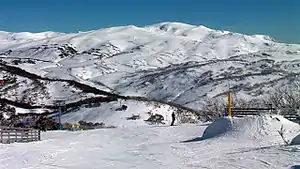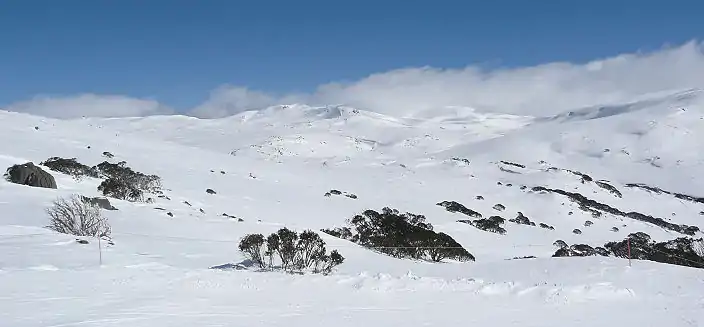Skiing in Australia
Skiing in Australia takes place in the high country of the states of New South Wales, Victoria and Tasmania, as well as in the Australian Capital Territory, during the southern hemisphere winter.
| Country | Australia |
|---|---|
| Governing body | Ski & Snowboard Australia |
| National team(s) | Australia |
Skiing began in Australia at the goldrush town of Kiandra, New South Wales, in 1861.[1] The first ski tow was constructed near Mount Buffalo, Victoria, in 1936. Australian skiers competed in the Winter Olympics for the first time in Oslo 1952 and have competed in all subsequent Games, winning medals at every Games since 1998.[2] Malcolm Milne became the first non-European to win a ski race world cup in 1969, and Olympic medalists include Zali Steggall, Alisa Camplin, Dale Begg-Smith, Lydia Lassila and David Morris in skiing and Torah Bright in snowboarding.[3][4]
Australia has extensive skiable terrain during the southern hemisphere winter in the south eastern states and Australian Capital Territory, between elevations of around 1250 m to 2200 m. Elevation of the snowfields in Australia varies with latitude; however, viable winter snows are generally found above 1500 m: Thredbo, near Mount Kosciuszko, has Australia's highest lifted point at 2037 m and its base elevation is 1365 m. Kiandra, in the Northern Skifields, has an elevation of 1400 m, while Mount Mawson near Hobart, Tasmania, is at 1250 m.[5][6][7][8]
Australia has several well developed downhill ski resorts, including Thredbo and Perisher in New South Wales, and Mount Hotham, Falls Creek and Mount Buller in Victoria. Cross country skiing is popular in such national parks as Kosciuszko National Park and Alpine National Park and is also possible within Namadgi National Park and in the Tasmanian Wilderness. Mount Buller has Australia's largest snow village with accommodation of 7000 beds, and is the largest most popular ski resort in Victoria.
History and major locations
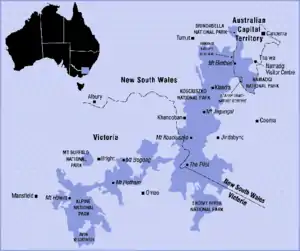
Towns with frost, snow and even ice include Barrington, New South Wales, Barrington Tops National Park, Bendemeer, New South Wales, Orange, New South Wales, Stanthorpe, Queensland, Applethorpe, Queensland, Warwick, Queensland, Walcha, New South Wales, Armidale, New South Wales, Wangaratta, Victoria and many more in all states and territories except the Northern Territory.
The sport of skiing is now practised in three States: New South Wales, Victoria and Tasmania, as well as in the Australian Capital Territory, during the Southern Hemisphere winter.[9] Skiable terrain stretches through large areas of territory from June to October and a number of well serviced resorts have been developed, including: Thredbo, Perisher Ski Resort, Charlotte Pass and Selwyn Snowfields in New South Wales; Mount Buller, Falls Creek, Mount Hotham, Mount Baw Baw and Mount Buffalo in Victoria; as well as the small resorts of Ben Lomond and Mount Mawson in Tasmania.[10]
New South Wales has the highest terrain and ski resorts: Thredbo's Karel's T-bar terminates at 2037 metres, Perisher's highest lifted point is a close second at 2034 metres and Charlotte Pass at 1990 metres. In Victoria, the highest lifted points are at Mount Hotham with 1845 metres, Falls Creek at 1842 metres, and Mount Buller at 1805 metres.[11]
Jindabyne is the main service town for the New South Wales resorts, but most Australian resort centres have on-snow accommodation. Other ski-service towns include Cooma and Adaminaby in NSW and Bright in Victoria. Canberra is situated around two hours' drive from the New South Wales ski-fields, while Melbourne is in good proximity to some of the Victorian resorts (less than two and a half hours’ drive to Mount Baw Bawand three to Mount Buller). The resort village of Dinner Plain in Victoria also has ski facilities.
The mainland's highest peak is Mount Kosciuszko at 2228 m.[12]
New South Wales
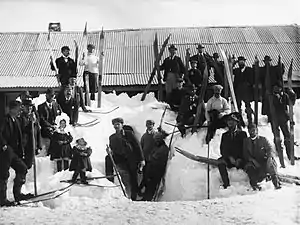
New South Wales is home to Australia's highest snow country, oldest skifields and largest resort. Recreational skiing in Australia began in 1861 at Kiandra, New South Wales, when Norwegian gold miners introduced the idea to the frozen hills around the town.[1][13] The first and longest surviving ski club in the world, The Kiandra Snow Shoe Club, was formed at Kiandra in that year.[7][14] [15]
Kiandra and the Northern Skifields
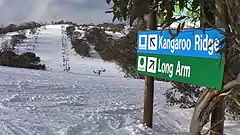
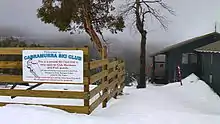
Kiandra is often isolated by deep snow which made it inaccessible during winter. In 1861, Norwegian miners introduced recreational skiing to the snowbound mining settlement after manufacturing over forty pairs[16] of both short skis known as skates and the longer snow shoes[17] during the months before the first winter snow. To avoid confusion with a conventional skate the skates were described as (two palings turned up at the front end and about four-foot long). There were no fence palings or posts in Kiandra in 1861.[18]
It has been claimed that an unidentifiable ski club (unnamed and without membership names) commenced in America in 1861.[19] The "Trysil Skytte- og Skiløberforening" (Shot and Ski Practitioner Association) was also founded in Norway, in 1861. The association held their first competition in January 1862 Alpine ski clubs were first founded in Munich, Germany 1891, Switzerland 1893, Arlberg, Austria 1901, followed by France and Italy. Sir Arnold Lunn founded the Kandahar Ski Club of Great Britain in 1924.
The "Kiandra Snow Shoe Club" held separate ski races for both ladies and children as early as 1885. Barbara Yan was the first identifiable woman documented as to having won a Downhill Skiing Championship. Yan also won the ladies downhill in 1887, the year her siblings won the girls' under-8 section and second in the under-12s.[20] In 1908 the club held the first ever documented International and Intercontinental Downhill Skiing Carnival. Results - America 1st, Australia 2nd, England 3rd.[21]
Australia's longest running skiing competition is the Balmain Cup.[22] By 1933 team racing was open to virtually all competitors from any club or imported talents but Arthur Balmain of Cooma believed this was unfair to local enthusiasts. He donated a perpetual trophy open only to competitors residing in or about the Southern Districts and only for members who held membership for twelve weeks in the local ski club. Arthur Balmain, whose company transported skiers to all localities, envisaged a competition that would encompass all clubs. He decreed that a team must compete for the Balmain Cup with all members competing in four disciplines: Downhill, Slalom, Jump and Langlauf. In 1946 the competition format for competitors eligibility was changed and the jump section was removed.[23]
In the wilderness region south of Kiandra, The Alpine Hut, near Mount Jagungal, was built in 1939 to cater for skiers. Access was arduous - via packhorse and ski.[24]
The Kiandra Goldrush was short-lived, but the township remained a service centre for recreational and survival skiing for over a century. The Kiandra courthouse closed as a police station in 1937, and was for a time used as a private residence, before becoming the Kiandra Chalet (until 1953) and later the Kiandra Chalet Hotel,[25] The owner of the Chalet ran a ski rope tow. The Chalet closed in 1973 and the building became a Roads Depot building.[26] Australia's first T-Bar was installed on Township Hill in 1957, but in 1978, Kiandra's ski lift operations re-located permanently to nearby Mount Selwyn (Selwyn Snowfields).[27] Selwyn is the most northerly of Australia's ski resorts with a base elevation of 1492 m and a top elevation of 1614 m. Selwyn is well suited to families and first timers, with 88% of terrain catering to beginners and intermediates, however the steeper gradient of the Racecourse Run provides some more challenging terrain for advanced skiers and boarders.[28] The longest run at Selwyn is the 800 m "Long Arm Run".
Longer slopes and more reliable snows lie further to the south and in the 20th century, the focus of recreational skiing in New South Wales shifted southward, to the Mount Kosciuszko region.[29]
Kosciuszko Region

In 1900, a hut was built at Bett's Camp, above the Thredbo Escarpment, and came into use for winter skiers. The Hotel Kosciusko was opened by the New South Wales Government in 1909 at what is now Sponars Chalet, near Smiggin Holes.[30]
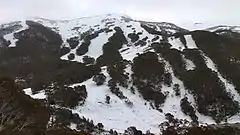
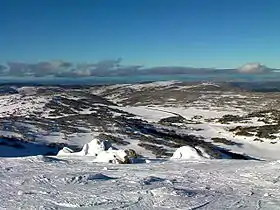
The first Kosciuszko Chalet was built at Charlotte Pass in 1930, giving relatively comfortable access to Australia's highest terrain.[31] In 1964, Australia briefly boasted the "World's Longest Chairlift" [citation needed], designed to carry skiers from the Thredbo Valley to Charlotte Pass, but technical difficulties soon closed the facility.[32][33] At 1760 m, Charlotte Pass has the highest village base elevation of any Australia ski resort and can only be accessed via over-snow transport in winter.[34] The growing number of ski enthusiasts heading to Charlotte Pass led to the establishment of a cafe at Smiggin Holes around 1939, where horse-drawn sleighs would deliver skiers to begin the arduous oversnow journey on skis to the Kosciusko Chalet.[35] It was the construction of the vast Snowy Mountains Hydro-Electric Scheme from 1949 that really opened up the Snowy Mountains for large scale development of a ski industry and led to the establishment of Thredbo and Perisher as leading Australian resorts.[36][37] The Construction of Guthega Dam brought skiers to the isolated Guthega district and a rope tow was installed there in 1957.[38]
Ski fields up by Kosciuszko's side were also established during this period, though their existence is now little realised. The Australian Alpine Club was founded in 1950 by Charles Anton with a view to establishing a chain of lodges for ski touring across the Australian Alps. Huts were constructed in the "Back Country" close to Mount Kosciuszko, including Kunama Hut, which opened for the 1953 season. A rope tow was installed on Mount Northcote at the site and opened in 1954. The site proved excellent for speed skiing, but the hut was destroyed in an avalanche, which also killed one person, in 1956.[39]
Anton also recognised the potential of the Thredbo Valley for construction of a major resort and village, with good vertical terrain. Construction began in 1957.[36] Today, Thredbo has 14 ski-lifts and possesses Australia's longest ski resort run, the 5.9 km from Karel's T-Bar to Friday Flat; Australia's greatest vertical drop of 672 m; and the highest lifted point in Australia at 2037 m[40][41]
The last establishment of a major skifield in NSW came with the development of Blue Cow Mountain in the 1980s. In 1987 the Swiss-designed Skitube Alpine Railway opened to deliver skiers from Bullocks Flat, on the Alpine Way, to Perisher Valley and to Blue Cow, which also opened in 1987.[37] The operators of Blue Cow purchased Guthega in 1991, and the new combined resort later merged with Perisher-Smiggins to become the largest ski resort in the Southern Hemisphere.[37] In 2011 Perisher had 47 lifts covering 1,245 hectares and four village base areas: Perisher Valley (elevation 1720m), Blue Cow Terminal (1890 m), Smiggin Holes (1680 m) and Guthega (1640 m).[42] The resort is spread across seven mountain peaks, with the highest lifted point being Mount Perisher Double Chair at 2,034 m and the greatest vertical drop on a single run being 355 m from the Ridge Chair at Blue Cow.[37]
Victoria
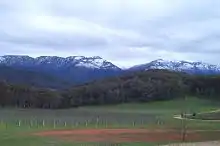
Victoria is the State with the greatest number of ski resorts in Australia. The highest peak in Victoria is Mount Bogong at 1986 m.[43]
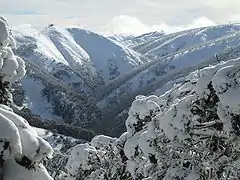
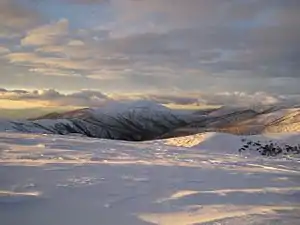
A hospice was built at Mount Saint Bernard (elevation 1540 m) around 1863 along a track developed to link the Victorian gold fields. Snowshoes were developed locally to assist winter travellers and a larger hospice built around 1884. Recreational and practical skiing was being practised in the area by the 1880s and 1890s with skis made from local timbers, and making use of single steering poles. The first winter traverse of the Victorian Alps was made in 1900, via the Hospice and Mount Hotham. The Hospice operated as a recreational ski location into the 1930s, but was destroyed by bushfire in 1939.[44]
Skiing began at Mount Buffalo in the 1890s and the Mount Buffalo Chalet in Victoria was constructed in 1910. Australia's first ski tow was constructed near Mount Buffalo in 1936.[45] Buffalo's first ski lodge was built at Dingo Dell in 1954. A bushfire in 2006 forced the temporary closure of the resort and negotiations are continuing over a new lease on the property.[46][47]
A stone cottage was built at Mount Hotham in 1925 to cater for a growing interest in sport of skiing and a Club was built in 1944 with the first ski tow installed in 1951.[48] A ski hut was erected at Mount Baw Baw, just 120 km East of Melbourne, in 1945 and a ski rope tow added in 1955.[49] The first ski lift went into service at Mount Buller in 1949, and in the same year a rope tow was installed at Falls Creek.[50] In 1957, Australia's first chairlift was installed at Falls Creek,[51] and the area is today the largest ski resort in Victoria.
The Mount Buller Interschools Event claims to be the largest interdisciplinary snow-sports event on earth. In 2008 it attracted 3500 participants.[34]
Snow play is also available at Mount Donna Buang.
Australian Capital Territory
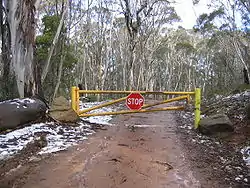
The most northerly ski fields in Australia are located in the A.C.T. - in the Brindabella Ranges which rise to the west of Canberra, the capital city of Australia, and include the Namadgi National Park in the A.C.T. and Bimberi Nature Reserve and Brindabella National Park in New South Wales. The highest mountain in the ACT is Bimberi Peak, which lies above the treeline at 1912 metres, at the northern edge of the Snowy Mountains.[43]
A ski chalet was constructed at Mount Franklin in 1938 to service the Canberra Alpine Club.[52] Ski runs were cleared and ski tows were improvised.[53] The chalet later operated as a museum before being destroyed in the 2003 bushfires.[54] A new shelter designed and built by University of Adelaide students opened in 2008. Today, cross country skiing is possible in the area, when conditions allow.[55] Cross Country skiing is also practised at Mount Gingera, which rises above the city of Canberra to an elevation of 1855m, and is the most prominent snow-covered peak above the city.[56][57]
Snow play is available at Corin Forest, near Canberra, at an elevation of 1200 m. A development plan was drafted following the 2003 Canberra bushfires which would see three 600 m chairlifts installed together with snowmaking facilities and accommodation at this site.[58]
As has proved to be the case throughout the neighbouring Kosciusko National Park ski resorts, recent developments in artificial snowmaking capacity would allow for the enhancement of previously utilised ski slopes in the ACT, but the Namadgi National Park Draft Management Plan of September 2005 downplayed the future development of skiing as a sport in the Park, citing environmental concerns and suggesting that "climate change" has made conditions "less favourable":[59]
Ski touring is a minor activity in Namadgi as snowfall is only adequate for skiing for short periods in winter and spring. In most years, snow play can occur over several weeks, even if snow is present in small patches on the higher peaks...
No facilities exist for alpine or downhill skiing within Namadgi, although there is a history of downhill skiing associated with the Canberra Alpine Ski Club and the Mt Franklin Chalet (destroyed in the 2003 bushfires). It is unlikely that Namadgi will be suitable for this activity in the future as climate change is causing conditions to become less favourable. More suitable locations exist and opportunities are available within Kosciuszko National Park.
Tasmania
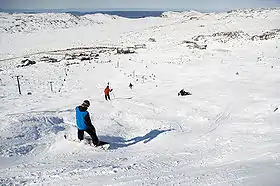
The most southerly ski fields in Australia are located in Tasmania, a mountainous island off the southern coast of Eastern Australia. Much of the state is subject to at least occasional winter snows. Mount Ossa is the highest point on the island at 1,614 m (5,295 ft) but Tasmania has eight mountains exceeding 1500 m and 28 above 1,220 m. Also notable is the Central Plateau, at an elevation of around 900 m. The capital city of Hobart is built at the base of Mount Wellington, which at 1270 m is snow-capped in winter.[60]
Tasmania's premier Alpine skiing operations are located at Ben Lomond, 60 km (37 mi) from Launceston.[61] The village is at 1460 m and the top elevation is 1,570 m (5,150 ft).[62] Its season usually begins in mid-July and in peak season, its runs are served by seven lifts.[63] Limited downhill ski operations also exist in the Mount Field National Park at Mount Mawson, which is approximately 89 kilometres north west of Hobart and rises from 1200 m to 1320 m altitude.[64]
One of Australia's most scenic alpine locations is located in Tasmania at Cradle Mountain, where cross country skiing is possible. Cradle Mountain is part of the Tasmanian Wilderness World Heritage Area, inscribed by UNESCO in 1982.[65]
Competitive skiing

Australia was a pioneer nation in the sport of ski racing, with annual ski races being conducted at Kiandra during the 19th Century. The Kiandra snow shoe club is the oldest ski club in the world.[66][67] The club was formed in 1861 by three Norwegians, Elias Gottaas, Soren Torp and Carl Bjerknes on the Kiandra Gold Fields, NSW. This original Kiandra ski club is now recognised as the first alpine snow ski club in the world, it also carries the distinction of being the longest continuously operating club. In 2006, the Holmenkollen Ski Museum confirmed that the first two ski clubs in the world were formed by Norwegians in 1861, "both in Australia and Norway".[68]
10 May 2011 The Federation of International Skiing included in a letter signed by the President Gian Franco Kasper the following statement: "I would like to commend you for having organised the first alpine ski races in the history of our sport."[69]
29 June 2011 Federation International Skiing wrote: "2011 is an historic year for Australian skiing, and the 150-year milestone is being celebrated across the nation's ski fields by many organisations. The FIS joins the congratulations for this important Australian anniversary, together for Kiandra's inaugural position in alpine skiing in the world."[69]
Ski races were conducted from 1861 then in 1908 the club held the world's first documented "International Ski Carnival". The results were: America,1st. Australia, 2nd. England, 3rd.[70][71] In addition to the International Downhill Race, events included races for boys under eight, ten, eleven and fourteen; boys and girls Open Championships were also conducted. The events concluded with a "New Chum" event and toboggan race.[72]
The Federation Internationale de Ski calendar lists various alpine and cross country skiing, as well as snowboarding and moguls competitions in Australia during the month of August.[73]
The Winter Olympics & World Cup Skiing
Australian skiers competed in the Winter Olympics for the first time in Oslo, 1952. Australian skiers have competed in all subsequent Winter Olympic Games and won medals at every Games since 1998.[2]
Australians have competed in Olympic Alpine Skiing; Biathlon; Cross Country Skiing; Freestyle Skiing; and also in Nordic Combined (one competitor in 1960).[74] Of these ski events, Australia has been most successful in the sport of Freestyle Skiing in which it has won Olympic medals, produced World Champions and over 100 world cup medals.[75]
Malcolm Milne competed for Australia in Alpine skiing at the 1968 and 1972 Olympic Games. His 1968 Olympics 24th placing in the Slalom Event remains the best performance by an Australian male in that event.[76] In 1969 he became the first non-European to win a men's World Cup downhill event - winning first place at Val d'Isère.[77] Steven Lee became the second Australian to take a World Cup victory, winning at Furano, Japan in 1985, and Zali Steggall became the third Australian (and first woman) at Park City, Utah in 1997.[77]
Alpine skier Zali Steggall won Australia's first skiing medal at the 1998 Nagano Olympics winning bronze in the women's slalom event. Australian freestyle skiers emerged as a world force from the mid-1990s, when Kirstie Marshall was placed 6th in the 1994 Lillehammer Olympics.[75] The Olympic Winter Institute of Australia was established by the Australian Olympic Committee in June 1998 in an effort to improve the performances of its Australian Winter Olympic Teams,[78] and Alisa Camplin won Australia's first Alpine Olympic gold medal in the Freestyle Skiing Women's Aerials at the Salt Lake City Olympics in 2002. Camplin won Bronze at the subsequent Torino Olympics in 2006, while Dale Begg-Smith won Australia's second skiing Gold in 2006 in the Freestyle Skiing Men's Moguls.[79][80] Begg-Smith won silver in the same event at the 2010 Vancouver Olympics,[81] while Lydia Lassila won gold for Australia in the Women's Aerials.[82]
The sport of snowboarding is also popular in the Australian skifields and Australia has been represented at the Olympics in this sport ever since it debuted at Nagano in 1998.[83] Torah Bright, of the Snowy Mountains town of Cooma, New South Wales, won gold for Australia at the Vancouver Olympics in 2010 in the women's snowboard halfpipe event.[84] Bright's gold medal - combined with the gold and silver skiing event medals - made 2010 Australia's most successful winter Olympic Games.[85] The Australian team was the only Southern Hemisphere team to secure medals and was ranked 13th in the overall medal tally. Australia's two gold medals equalled the gold medal haul of former Winter Olympic host nation France and surpassed those of former host nations Italy, Japan and Croatia (in the Former Yugoslavia).[86] A parodical bid for Australia to host the Olympic Games at Smiggin Holes was launched by satirical sports commentators Roy and HG during the Salt Lake City Olympics: see Smiggin Holes 2010 Winter Olympic bid.
Cross country & back country skiing
The Kosciuszko Main Range in the Snowy Mountains of New South Wales offer some of the most challenging cross-country and back-country skiing in Australia, notably Watsons Crags and Mount Twynam on the steep Western Face of the Range.[87][88] The Mount Jagungal wilderness area provides some of the most isolated back-country ski terrain. High country huts, often a legacy of the era of cattle grazing in the mountains, provide emergency shelter in these regions.[89] Seaman's Hut, near Kosciusko, was built as a refuge in 1929 to commemorate Laurie Seaman, who was separated from his party and died in a 1928 blizzard while attempting to cross-country ski to Mount Kosciusko.[90]
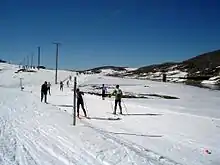
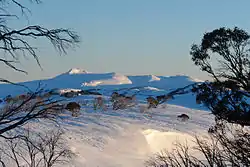
Dedicated Cross Country ski resorts are located at Lake Mountain, Mount Stirling and Mount St Gwinear in Victoria and popular areas for back country skiing and ski touring in the Alpine National Park, Yarra Ranges National Park and the Baw Baw National Park include: Mount Bogong, Mount Feathertop, Bogong High Plains, Mount Howitt, Mount Reynard and Snowy Plains. The Kangaroo Hoppet is a leg of the Worldloppet cross-country race series which is conducted on the last Saturday of August each year, hosted by Falls Creek in Victoria. The showpiece 42-kilometre race attracts thousands of spectators and competitors.[34]
Cross country skiing can be possible in the Brindabella Ranges which rise to the west of Canberra, in the A.C.T, and include the Namadgi National Park and Bimberi Nature Reserve. Mount Franklin Chalet, built in 1938, in the A.C.T. played a pioneering role in providing lifted ski runs in Australia, however the chalet was converted to a museum and subsequently destroyed by fire in 2003, so today only cross country skiing can be practised in the area (when conditions allow).[91] Cross Country skiing is also practised at Mount Gingera, elevation 1855 m, a prominent snow-covered peak above the city of Canberra.[56][57]
When conditions allow, Australia's rugged island State of Tasmania also offers cross country skiers some scenic terrain - notably in the UNESCO World Heritage area around Cradle Mountain.[65] Tasmania has 28 mountains above 1,220 m and much of the island is subject to at least occasional winter snow.[60]
The Australian High Country is populated by unique flora and fauna including wombats, wallabies, echidnas, and the Snow Gum.[92] The Alpine regions are subject to environmental protection, which has limited the scope of commercial development of skiiable terrain,[93] however Australia has extensive cross country skiing terrain.[94][95]
A landmark expedition in early Australian cross country skiing was conducted in 1927, when William Hughes, of the Kiandra Snow Shoe Club, together with four members of the Ski Club of Australia made the first historic ski traverse from Kiandra to the Hotel Kosciusko (now Sponars Chalet). Their eventful journey, via the Mount Jagungal Wilderness and across freezing rivers, is retold in Klaus Hueneke's book "Kiandra to Kosciusko" and was commemorated by 150 ski tourers in 1977 in an event organised by the Kosciusko Huts Association.[96]
Snow conditions
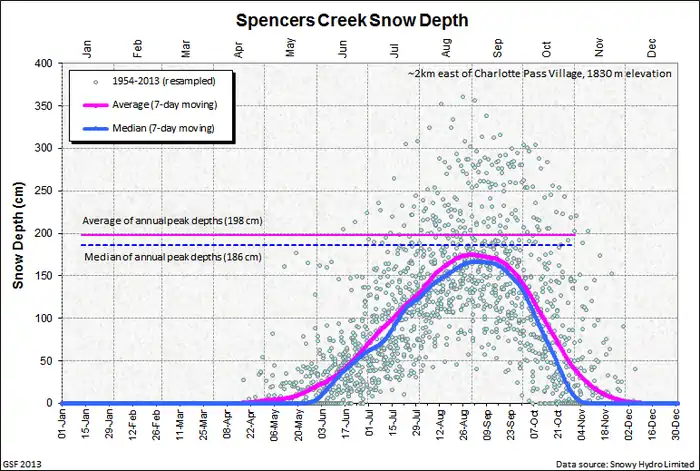

According to the Australian Government's "Bureau of Meteorology", in most years snow is sufficient above about 1500 metres to sustain a "viable ski industry". However, snow falls can vary greatly from year to year. In 1973 temperatures remained too warm, while in 1982 it was too dry for much of a snow season. However, some other years have abundant snow – the Bureau cites 1981 as an example. The unpredictability of Australian snow conditions was highlighted in 2006 when severe drought and a poor snow season gave way to a "White Christmas" and abundant snow falls in the alpine regions of New South Wales, Victoria and Tasmania and even a low altitude snow fall on 25 December in the Dandenong Ranges on Melbourne's north-eastern fringe.[97] Snow making equipment at ski resorts has reduced uncertainty in recent times.[10] In New South Wales, a heavy natural snow season can see a base of up to 3.6 metres in August, at an elevation of 1830 m at Spencer's Creek, (near Charlotte Pass) - see below chart. Typically, depths will be lower than this.[98]
Low altitude and often dry climate; as well as seasonal (early spring) dust storms in the Simpson Desert depositing red dust on the ranges (causing less UV reflection and therefore faster melting) keep the snow season relatively short (June-Oct). Heavy snow can fall however, at any time between April and December in the Australian High Country (see chart from Snowy Hydro). The official opening of the ski season for most resorts coincides with the Queens Birthday Long Weekend on the second Monday in June.
List of downhill ski resorts

List of cross country ski resorts and backcountry locations

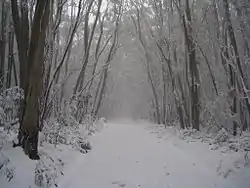
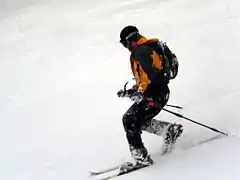
Cross country ski resorts:
Major ski locations:
- New South Wales:
- Victoria
- Tasmania
- Australian Capital Territory
Gallery

 Blue Cow, Perisher
Blue Cow, Perisher Mount Hotham Village
Mount Hotham Village An OverSnow Vehicle at Perisher
An OverSnow Vehicle at Perisher
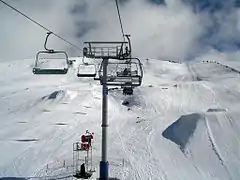 The Ruined Castle chairlift and terrain park, Falls Creek, Victoria
The Ruined Castle chairlift and terrain park, Falls Creek, Victoria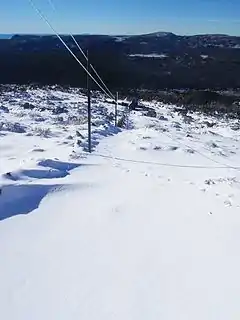 Top of Mount Mawson tow, Tasmania
Top of Mount Mawson tow, Tasmania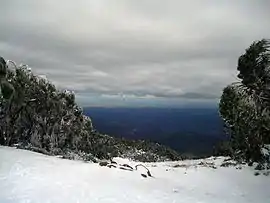 The view across Gippsland from Mount Baw Baw, Victoria
The view across Gippsland from Mount Baw Baw, Victoria Mount Buller village, Victoria.
Mount Buller village, Victoria.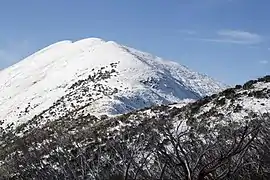 Mount Feathertop, Victoria
Mount Feathertop, Victoria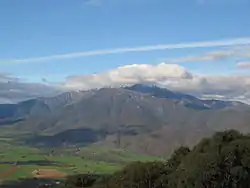 Mount Bogong, the highest mountain in Victoria
Mount Bogong, the highest mountain in Victoria Mount Ossa, the highest mountain in Tasmania, seen from Pelion Plains
Mount Ossa, the highest mountain in Tasmania, seen from Pelion Plains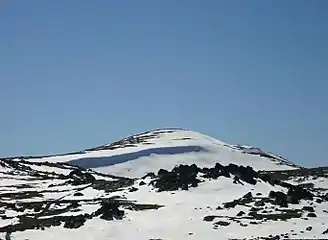 Mount Kosciuszko, New South Wales - Australia's highest peak - October 2006
Mount Kosciuszko, New South Wales - Australia's highest peak - October 2006
See also
References
- "Kiandra - Gold fields to Ski Fields" ISBN 0646463373
- "Australia at the Winter Olympics". Archived from the original on 12 February 2010. Retrieved 22 February 2010.
- Oakes-Ash, Rachael (30 July 2007), "Snow Divide - Australia vs New Zealand", The Age Newspaper Travel Blog, Melbourne, retrieved 4 May 2010
- Australian Olympic Committee, "Winter Olympic Games", Official Website of the AOC, retrieved 4 May 2010
- Sydney Morning Herald (21 November 2008), "Kiandra - Culture and History", The Sydney Morning Herald, retrieved 4 May 2010
- "Australia Resorts", ski.com.au, archived from the original on 31 December 2012, retrieved 4 May 2010
- Selwyn Snowfields, "History", Selwyn Snowfields Website, retrieved 4 May 2010
- Kiandra Historical Society, "Ski Clubs of Kiandra", Kiandra Historical Society Website, retrieved 4 May 2010
- "Skiing & Highlands", Totaltravel Website, archived from the original on 10 October 2009, retrieved 4 May 2010
- Australian Bureau of Meteorology. "Climate Education". BOM Website. Archived from the original on 17 March 2009. Retrieved 4 May 2010.
- "Home and away". The Sydney Morning Herald. 13 November 2008.
- Footnote: As regards regions with skiable terrain, the Australian Government's Geoscience Australia Website records the highest mountains by State and Territory as follows: Mount Kosciuszko, NSW, 2228 m; Mount Bogong, VIC, 1986 m; Bimberi Peak, ACT, 1912 m; Mount Ossa, TAS, 1617 m (while the highest mountain on Australian Territory is actually Mawson Peak, Heard Island, at 2745 m, which despite being snowbound, has no ski industry owing to its extreme isolation).
- Sydney Morning Herald (21 November 2008), "Kiandra - Culture and History", The Sydney Morning Herald, retrieved 4 May 2010
- Clarke, Norman W. (2012), "World's First Alpine Ski Club", Kiandra Pioneer Ski Club (1870) Ltd, p. 17/21, ISBN 978-0-646-58842-1
- "The first and oldest identifiable alpine ski club in the world". Retrieved 24 February 2019.
- ‘'Scores of young people are frequently engaged climbing the lofty summits with snow shoes'’ 6 August 1861.
- ’'The roads were passable except with snow shoes or the more novel mode of travelling on skates'’. Braidwood Observer. 12 August 1861.
- "There is little or no timber in the country here, and whatever there is, is of no use for fencing or house building purposes." The Yass Courier, 4 August 1862.
- Butte Record, Marysville, "Daily Appeal" 26 January 1861.
- Manaro Mercury, Cooma & Bombala Advertiser, 10 August 1887.
- The Melbourne Argus, 6 July 1908.
- "The Balmain Cup - Snow Skiing Competition from 1933". members.ozemail.com.au.
- "Kiandra GoldFields To Ski Fields" ISBN 0646463373
- AAC - History
- "snowytimes.com Is For Sale". www.snowytimes.com.
- "Kiandra". The Sydney Morning Herald. 8 February 2004.
- "Selwyn Snow Resort - History". www.selwynsnow.com.au.
- "Selwyn Snow Resort - Mountain Information". selwynsnow.com.au.
- The history of skiing at Kiandra has been the subject of several studies, including 1959's "Historic Kiandra", written by the Kiandra Historical Society and Kiandra Goldfields to Skifields (2006) by Norman W. Clarke
- :: Welcome to Kosciusko Alpine Club :: Archived 13 September 2009 at the Wayback Machine
- Charlotte Pass Ski Resort - Kosciuszko Chalet Hotel Archived 10 March 2011 at the Wayback Machine
- "Of ice and men". The Sydney Morning Herald. 24 January 2009.
- Archived 12 September 2009 at the Wayback Machine
- Upe, Robert; Darby, Jim; Holt, Russell; Bredow, Susan (6 June 2009). "50 reasons to love Australian snow". The Sydney Morning Herald.
- "Perisher - History". Archived from the original on 6 October 2014. Retrieved 8 December 2014.
- "Thredbo's History".
- "perisher.com.au". Retrieved 9 December 2014.
- "Christiana Capital : Guthega Ski Resort". www.christianacapital.com.
- History of the Australian Alpine Club
- "About Thredbo".
- "NRMA Membership - 24/7 Roadside Assistance Breakdown Cover - The NRMA". www.mynrma.com.au.
- Archived 24 March 2010 at the Wayback Machine
- "Highest Mountains - Geoscience Australia". Archived from the original on 6 April 2010. Retrieved 28 April 2010.
- Australian Alpine Club Heritage
- "Mount Buffalo National Park". 19 November 2013.
- http://www.mtbuffaloresort.com.au/environment_chalet_history_time.php
- Miletic, Daniella (13 December 2006). "Lodge destroyed on Mount Buffalo". The Age. Melbourne.
- "Mount Hotham - History".
- "About Mt Baw Baw". Archived from the original on 12 June 2009. Retrieved 23 July 2009.
- "Mount Buller - Culture and History". The Sydney Morning Herald. 26 November 2008.
- History of the Resort - Official Home of Falls Creek Alpine Resort Archived 25 September 2009 at the Wayback Machine
- "Bimberi Nature Reserve". 19 November 2013.
- What's On Archived 25 January 2014 at the Wayback Machine
- Canberra Alpine Club Archived 25 January 2014 at the Wayback Machine
- "Namadgi National Park". 19 November 2013.
- Namadgi National Park, ACT - Tourism Australia Archived 21 February 2012 at the Wayback Machine
- INSTRUMENT NO. 111 OF 1999 ACT Legislation
- Corin- Future Plans Archived 12 September 2009 at the Wayback Machine
- "Inquiry into Namadgi National Park Management" (PDF). Retrieved 21 November 2017.
- Statistics, c=AU; o=Commonwealth of Australia; ou=Australian Bureau of (13 September 2002). "Chapter - Mountains". www.abs.gov.au.
- "What to Do". Archived from the original on 5 May 2007. Retrieved 17 May 2011.
- Ben Lomond | Offpiste | Piste Maps | Snow Conditions / Reports | Ski Images Archived 7 October 2013 at the Wayback Machine
- Snow's up on Ben Lomond Tasmania News - The Mercury - The Voice of Tasmania
- Southern Tasmanian Ski Association
- Parks & Wildlife Service - Tasmanian Wilderness World Heritage Area
- "World's First Alpine Ski Club" second edition ISBN 9780646588421
- "Kiandra - Culture and History". The Sydney Morning Herald. 21 November 2008.
- Ski Museum letter published "World's First Alpine Ski Club" second edition ISBN 9780646588421
- FIS letters published "World's First Alpine Ski Club" second edition ISBN 9780646588421
- The Melbourne Argus, 6 July 1908
- Full race results: "Kiandra - Gold fields to Ski Fields" ISBN 0646463373
- This has been referenced to "Kiandra : gold fields to ski fields" / by Norman W. Clarke. [Sydney : Kiandra Pioneer Ski Club (1870) Ltd. ], 2006. Description: 187 p. : ISBN 0-646-46337-3
- "International Ski Federation Listed Events in Australia".
- "Vancouver 2010: Winter Sports". Archived from the original on 12 February 2010. Retrieved 22 February 2010.
- Vancouver 2010: Freestyle Skiing at the Wayback Machine (archived 12 February 2010)
- "Australian Olympic Committee: 1968 Grenoble".
- "The Age Blogs: Travel". The Age. Melbourne.
- "Best of Buenos Aires 2018". olympics.com.au.
- "Australian Olympic Committee: AUS Olympic Champions". olympics.com.au.
- A history of Australia's involvement at the Winter Olympics can be found on the Australian Olympic Committee's corporate website at
- Brodie, Will; Spits, Scott (15 February 2010). "Australian Dale Begg-Smith settles for silver". The Sydney Morning Herald.
- "Vancouver 2010: Freestyle Skiing". Archived from the original on 26 February 2010. Retrieved 2 March 2010.
- "Vancouver 2010: Snowboard". Archived from the original on 12 February 2010. Retrieved 22 February 2010.
- "Vancouver 2010: Bright lands golden run". Archived from the original on 22 February 2010. Retrieved 22 February 2010.
- "Vancouver 2010: Australia records best ever Winter Games". Archived from the original on 5 March 2010. Retrieved 2 March 2010.
- "Vancouver 2010". Archived from the original on 26 February 2010. Retrieved 2 March 2010.
- "OzBC.net - NSW Backcountry - Watson's Crags".
- "OzBC.net - NSW Backcountry - Twynam West Spur / Tenison Woods Knoll".
- http://www.kosciuszkohuts.org.au/thehuts.html
- "High Country Huts". Archived from the original on 3 June 2009. Retrieved 21 July 2009.
- Stateline Canberra Archived 2 November 2011 at the Wayback Machine
- "50 reasons to love Australian snow". The Sydney Morning Herald. 6 June 2009.
- See "Kosciuszko National Park: Contemporary Management". New South Wales Department of Education and Training, Riverina Environmental Education Centre.
- "XC - The Australian cross country skiing site". www.hoppet.com.au.
- Australian Alps - Tourism Australia Archived 21 February 2012 at the Wayback Machine
- "NSW Nordic Ski Club - Kiandra to Kosciusko". Archived from the original on 21 November 2008. Retrieved 21 July 2009.
- "SIGNIFICANT WEATHER - December 2006". www.bom.gov.au.
- "Snowy Hydro - Water Resources - Snow Depths Calculator". Archived from the original on 11 May 2009. Retrieved 20 July 2009.
External links
![]() Media related to Skiing in Australia at Wikimedia Commons
Media related to Skiing in Australia at Wikimedia Commons
- Mini-documentary on Skiing Kiandra
- 15oth Anniversary of skiing at Kiandra from the New South Wales National Parks and Wildlife Service.
- Snow Australia
- Australian Alps National Parks
- Snowy Hydro Snow Depth Charts
- Bureau of Meteorology Climate Education
- Australia at the Winter Olympics
- Ski & Snowboard Australia
- Victorian Cross Country Ski Team
- Cross Country Skiing Australia
- Tasmanian Wilderness World Heritage Area
- 50 Reasons to Love Australian Snow, Sydney Morning Herald, 6 June 2009.
- The Australian Alpine Club
- Australian ski lift directory. Details of all of the 400 ski lifts that have been built in Australia.
- Thredbo - Ski Resorts in NSW
- Perisher - Ski Resorts in NSW
